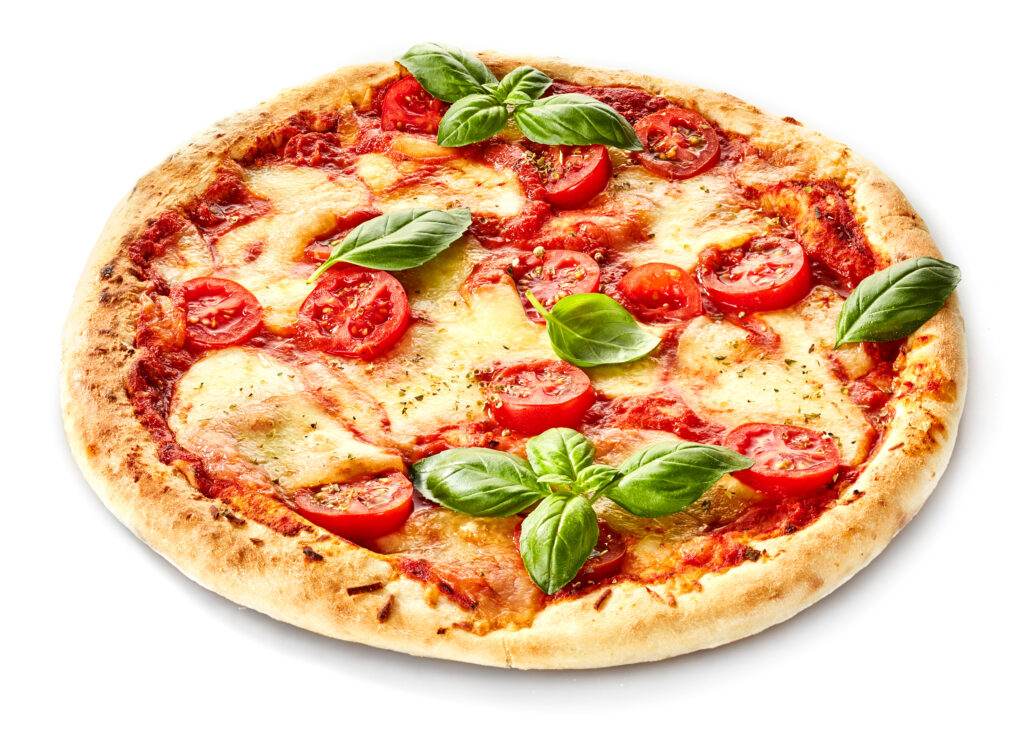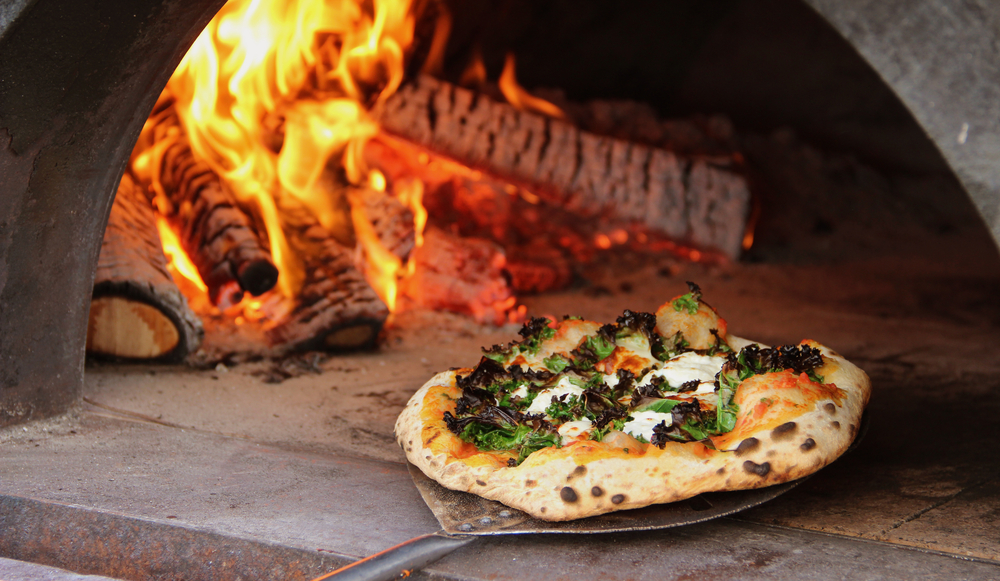People all throughout the world adore pizza and eat it frequently. Have you ever wondered what the dish is known as in Italy, where it originated?

It turns out that in Italy, the name “pizza” refers to a particular variety of tomato pie. It’s crucial to understand that the word “pizza” has various meanings around the world, which may surprise some people.
In restaurants in Italy, pizza is often served whole and eaten with a knife and fork. But in more informal settings, it is hand-cut into wedges and consumed.
It is also important to note that there are numerous pizza varieties throughout Italy, each with distinctive qualities and regional variances.
Everyone may enjoy a pizza, whether it is the traditional Margherita or the robust Neapolitan form.
History of Pizza in Italy
Pizza is a beloved Italian dish that has become a staple around the world. In Italy, pizza is a cultural icon that has a long and fascinating history.

In this section, we will explore the origins of pizza, its evolution in Naples, and the creation of the famous Pizza Margherita.
Origins of Pizza
The origins of pizza can be traced back to ancient civilizations such as the Greeks, Egyptians, and Romans, who all had some form of flatbread topped with herbs, cheese, and other ingredients.
However, modern pizza as we know it today originated in Naples, Italy in the late 18th century.
Pizza was initially a dish for the poor, sold by street vendors and made with simple ingredients such as tomatoes, cheese, and bread.
It was not until the late 19th century that pizza gained popularity outside of Naples.
Pizza in Naples
Naples is the birthplace of pizza and remains a hub for pizza lovers around the world. In Naples, pizza is taken very seriously, and there are strict rules about what can be considered a true Neapolitan pizza.
For example, the dough must be made with specific types of flour, and the pizza must be cooked in a wood-fired oven.
The popularity of pizza in Naples grew rapidly, and by the early 20th century, pizzerias were opening up all over the city.
Today, Naples is home to some of the most famous pizzerias in the world, including Pizzeria Brandi, where the Pizza Margherita was created.
Pizza Margherita
The Pizza Margherita is perhaps the most famous pizza in the world and was created in Naples in 1889. The story goes that Queen Margherita of Savoy visited Naples and requested to try the local pizza.
The pizza maker, Raffaele Esposito, created a pizza in honor of the queen that featured the colors of the Italian flag: red (tomatoes), white (mozzarella cheese), and green (basil).
The Pizza Margherita became an instant hit and remains one of the most popular pizza varieties to this day. It is a testament to the simplicity and beauty of Italian cuisine.
The history of pizza in Italy is a fascinating tale of humble street food that has become a global phenomenon.
From its origins in Naples to the creation of the Pizza Margherita, pizza has become a symbol of Italian culture and a beloved dish around the world.
Types of Pizza in Italy
When it comes to pizza, Italy is the birthplace of this beloved dish. There are many different types of pizza in Italy, and each region has its own unique style.

In this section, we will explore some of the most popular types of pizza in Italy.
Neapolitan Pizza
Neapolitan pizza is perhaps the most famous type of pizza in Italy. It is a traditional pizza that originated in Naples and is made with San Marzano tomatoes, mozzarella cheese, fresh basil, and extra-virgin olive oil.
The crust is soft and chewy, and the pizza is cooked in a wood-fired oven at high temperatures.
Sicilian Pizza
Sicilian pizza is a thick, rectangular pizza that is typically topped with tomato sauce, cheese, and various toppings such as onions, anchovies, and olives. The crust is crispy on the outside and soft on the inside, and the pizza is cut into squares.
Pizza al Taglio
Pizza al taglio, also known as “pizza by the slice,” is a popular type of pizza in Rome. It is a rectangular pizza that is baked in large trays and sold by weight.
Customers can choose from a variety of toppings, including vegetables, meats, and cheeses.
Pizza Fritta
Pizza fritta is a fried pizza that is popular in Naples. It is made by frying a ball of pizza dough and then filling it with tomato sauce, cheese, and other toppings. The result is a crispy, savory pizza that is perfect for a quick snack.
Roman Pizza
Roman pizza is a thin-crust pizza that is typically cooked in a wood-fired oven. It is often topped with simple ingredients such as tomatoes, mozzarella cheese, and fresh basil.
Roman pizza is known for its crispy crust and light, airy texture. Italy is home to many different types of pizza, each with its own unique style and flavor.
Whether you prefer a classic Neapolitan pizza or a crispy Roman pizza, there is something for everyone to enjoy.
Ingredients in Italian Pizza
When it comes to Italian pizza, the ingredients used are just as important as the cooking process itself. In this section, we’ll break down the key ingredients used in making authentic Italian pizza.

Dough
The dough is the foundation of any pizza, and Italian pizza is no exception. The dough used in Italian pizza is made from flour, water, yeast, and salt. The flour used is typically type “00” flour, which is finely ground and has a low gluten content. The dough is then left to rise for several hours before being shaped and topped.
Tomato Sauce
The tomato sauce used in Italian pizza is made from San Marzano tomatoes, which are grown in the volcanic soil near Mount Vesuvius.
The tomatoes are peeled, seeded, and crushed by hand, then mixed with a little salt and olive oil. The sauce is then spread thinly over the pizza dough, leaving a small border around the edge.
Cheese
Mozzarella is the most commonly used cheese in Italian pizza. It is made from cow’s milk and has a mild flavor and a soft, stretchy texture.
Another type of cheese that is often used is buffalo mozzarella, which is made from the milk of water buffalo and has a creamier texture and a slightly tangy flavor.
Other types of cheese that may be used include provolone, ricotta, and gorgonzola.
Toppings
The toppings used in Italian pizza can vary widely depending on the region and the season. Some popular toppings include:
- Basil: A fragrant herb that is often used fresh as a topping or added to the tomato sauce.
- Oregano: A pungent herb that is often used dried as a topping or added to the tomato sauce.
- Anchovies: Small, salty fish that is often used sparingly as a topping.
- Meat: Italian pizza may be topped with various types of meat, such as ham, prosciutto, or sausage.
- Onions: Sliced onions may be used as a topping to add sweetness and texture.
- Vegetables: Italian pizza may be topped with various types of vegetables, such as mushrooms, bell peppers, or artichokes.
- Olives: Pitted olives may be used as a topping to add saltiness and flavor.
- Garlic: Minced garlic may be used as a topping or added to the tomato sauce for extra flavor.
Overall, the key to making authentic Italian pizza is to use high-quality ingredients and to keep the toppings simple and fresh.
By following these guidelines, you can create a delicious pizza that is both satisfying and authentic.
Pizza Making in Italy
Wood-Fired Ovens
When it comes to making pizza in Italy, one of the most important aspects is the use of wood-fired ovens. These ovens can reach high temperatures of up to 900°F, allowing the pizza to cook quickly and evenly. The intense heat also gives the pizza its signature crispy crust and slightly charred flavor.

Pizzaioli
Another essential element of pizza making in Italy is the pizzaiolo, or pizza maker. These skilled artisans are trained in the art of pizza making and have a deep understanding of the dough, sauce, and toppings. They know how to work with the wood-fired oven to create the perfect pizza, and they take great pride in their craft.
Pizza Styles
There are many different styles of pizza in Italy, each with its unique characteristics. The most famous is the Neapolitan pizza, which is made with San Marzano tomatoes, mozzarella cheese, and fresh basil.
The crust is thin and chewy, with a slightly raised edge called the cornicione.
Another popular style is pizza alla pala, which is a type of flatbread that is baked on a long paddle and cut into rectangular slices. This style is popular in Rome and other parts of central Italy.
In addition to these classic styles, there are many other regional variations, such as the capriccioso, which is topped with ham, mushrooms, artichokes, and olives, and the pizza siciliana, which features anchovies, onions, and tomatoes.
Pizza Crust
The crust is one of the most important elements of a good pizza, and in Italy, it is taken very seriously.
The dough is typically made with high-quality flour, water, salt, and yeast, and it is left to rise for several hours before being stretched and shaped by hand.
The crust should be thin and crispy, with a slightly chewy texture. It should also have a distinct flavor from the wood-fired oven and the high-quality ingredients used in the dough.
Authentic Neapolitan Pizza
One of the most famous types of pizza in Italy is the pizza Margherita, which is named after Queen Margherita of Savoy.
It is made with San Marzano tomatoes, mozzarella cheese, and fresh basil, and it is said to represent the colors of the Italian flag.
To be considered a true Neapolitan pizza, it must be made with specific ingredients and cooked in a wood-fired oven at a high temperature. It should have a thin, crispy crust and a slightly chewy texture.
Other Pizza Styles
While Neapolitan pizza is the most famous, there are many other styles of pizza in Italy that are equally delicious.
The pizza alla pala, for example, is a type of flatbread that is popular in central Italy. It is based on a long paddle and cut into rectangular slices.
Another popular style is the pizza Napoletana, which is similar to the Neapolitan pizza but has a thicker crust and more toppings. It is often served with a variety of meats, vegetables, and cheeses.
Pizza making in Italy is an art form that has been perfected over centuries. From the use of wood-fired ovens to the skilled pizzaiolo, every element of the process is carefully considered to create the perfect pizza.
Whether you prefer a classic Neapolitan pizza or a regional variation, there is no denying that Italian pizza is some of the best in the world.
Italian Pizza Culture
Pizza is an integral part of Italian cuisine and culture. It is one of the most popular and beloved foods in Italy and around the world.
In this section, we will explore the different aspects of Italian pizza culture, including its history, its role as street food, its place in Italian cuisine, and its significance in Italian-American culture.
Pizza as Street Food
In Italy, pizza is often enjoyed as a quick and easy meal on-the-go. It is commonly sold as street food, with vendors offering slices of pizza al taglio (pizza by the cut) to hungry passersby.
This type of pizza is typically rectangular in shape and is sold by weight. It is a popular choice for a quick lunch or snack, and it is often eaten while standing up or walking around.
Pizza in Italian Cuisine
Pizza is an iconic dish in Italian cuisine, and it has a long and storied history. It is believed that pizza as we know it today originated in Naples, in the Campania region of Southern Italy.
The Associazione Verace Pizza Napoletana (AVPN) was founded in Naples in 1984 to protect and promote the traditional Neapolitan pizza.
The AVPN has strict guidelines for what constitutes a true Neapolitan pizza, including the use of specific ingredients, such as San Marzano tomatoes and buffalo mozzarella, and the use of a wood-fired oven.
Pizza in Italian-American Culture
Pizza has also played a significant role in Italian-American culture. Italian immigrants brought their love of pizza with them to the United States, and pizza quickly became a popular food in cities with large Italian populations, such as New York and Chicago.
Today, pizza is a staple in American cuisine, and there are countless pizzerias across the country.
Conclusion
Pizza is more than just a food in Italy; it is a cultural icon. From its origins as street food in Naples to its place in Italian cuisine and its significance in Italian-American culture, pizza has a rich and fascinating history.
Whether you prefer a classic margherita or a more adventurous topping combination, there is no denying the universal appeal of pizza.
Conclusion
We have learned that pizza in Italy is simply referred to as “pizza.” However, there are other words that Italians might use to describe savory and sweet pies, such as crostata and torta.
The word crostata means the pie’s edge, and similar to a pie, pizzas have a soft crust on the inside.
Pizza has a rich history, dating back to ancient civilizations like the Greeks and Persians. The modern-day pizza that we know and love originated in Naples, Italy, in the late 18th century.
It quickly became a popular street food and eventually spread throughout Italy and the world.
Pizza has also been recognized by UNESCO as an intangible cultural heritage of humanity, highlighting its cultural significance and importance.
Additionally, the European Union has protected the traditional Neapolitan pizza, ensuring that it is made with specific ingredients and cooking methods.
During World War II, pizza became a symbol of resistance for the people of Naples, who continued to make and sell pizza despite the difficult circumstances.
Today, pizza is enjoyed all over the world, with countless variations and toppings.
Some interesting facts about pizza include the origin of the word “pizza,” which is believed to come from the Latin word “pinsere,” meaning “to pound” or “to stamp.”
Additionally, the first pizza-like food was believed to be ancient pita bread topped with herbs, garlic, and olive oil.
Pizza is a delicious and mouthful food that has a rich history and cultural significance. From its humble beginnings in Naples to its worldwide popularity today, pizza has come a long way.
Whether you prefer a classic Margherita or a unique topping combination, pizza is sure to satisfy your taste buds.







Add comment